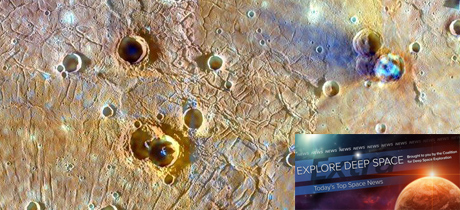Subscribe to our Daily Newsletter:
Don’t miss the latest developments in space policy, science, and exploration with Deep Space Extra, delivered directly to your inbox from Monday to Friday.
|
|
Here is a list of news that were published in our Newsletter the week of June 18, 2023:
Human Space Exploration:
- India joins NASA’s Artemis Accords for collaborative lunar exploration
- Russian cosmonauts toss old equipment overboard on ISS spacewalk
- Ecuador signs Artemis Accords
- Europe hands Artemis II Moon mission’s service module over to NASA
- Swedish astronaut ‘fast-tracked’ to join crew of upcoming private Axiom Space mission
- Boeing CEO says company still committed to Starliner
- China attracts Moon base partners, outlines project timelines
- NASA picks 7 companies to advance commercial space capabilities
Space Science
- Euclid, a European Space Agency (ESA) space telescope, to launch from Cape Canaveral, on July 1 to study one of cosmology’s greatest mysteries, dark energy
- The expansion of the universe could be a mirage, new theoretical study suggests
- Sun unleashes giant X-flare in outburst that could spark auroras on Mars (video)
- NASA Earth Information Center opens in DC
- Glaze spells out priorities if budget cuts materialize
- European probe captures stunning up-close views of planet Mercury during brief flyby (video, photos)
- NASA’s Juno mission spots eerie green light on Jupiter: Here’s what scientists think it is
- A dynamic form of dark energy may explain strange radiation signal from the early universe
- Life in the cosmos: JWST hints at lower number of habitable planets
- Even galaxies recycle
- Surprise! Jupiter’s ocean moon Europa may not have a fully formed core
- Scientists conduct first test of a wireless cosmic ray navigation system
Opinion
- Investing in space exploration research and technology
Forbes.com (6/16): Lofty goals, like those associated with space exploration, can pay impressive dividends, according to Dylan Taylor, who is the chair and CEO of Voyager Space Holdings. Taylor walks readers through some examples that include technical development and science conducted aboard the International Space Station (ISS) and global cooperation. As NASA’s Artemis program looks to human exploration of the Moon and Mars, there is more to come, he predicts. Those include resources mined from the Moon. Taylor also notes the success of NASA’s Double Asteroid Redirection Test (DART) from last year that offers a promising strategy for diverting asteroids and comets on a course to impact Earth. - Saving the Hubble telescope is a job worth paying for
Washington Post (6/17): In an op-ed, Adam Minter, a Bloomberg opinion columnist, calls on NASA to invest in a mission to boost the altitude of the Hubble Space Telescope, which was launched in 1990 and last serviced by NASA space shuttle astronauts in 2009. The pioneering space observatory’s altitude has descended to 330 miles and could become too low to keep it from deorbiting. Recently, NASA has solicited proposals from commercial interests to demonstrate a satellite reboost of Hubble on a no exchange of fees basis. “The better path for NASA, and the Hubble Space Telescope, is to offer to pay for a servicing mission,” writes Minter. “Doing so would likely incentivize more and potentially better proposals, and spur further innovation in the emerging satellite repair industry.”
Other News
- Space Force missile-warning satellites drawing congressional attention
- Outer space is becoming a minefield of dangers – we need better visibility now
- Senate Appropriators adopt FY 2024 spending caps
- A new mission will grab dead satellites and push them into the atmosphere to burn up
- FAA reduces airspace restrictions for Cape Canaveral launches
- Live coverage: Delta 4-Heavy lifts off with NRO spy satellite
- Intelsat orders another servicing mission from Northrop Grumman’s SpaceLogistics
- Live coverage: ULA scrubs Delta 4-Heavy launch attempt
- A chaotic trajectory for NASA’s budget
- Space Development Agency’s missile warning satellites transmit first images
- “You’re not in a simulator”: Remembering the ride of Sally Ride & the achievements of women in space
- The Moon, Venus, Mars and bright stars shine in a summer celestial gathering this week. Here’s how to see it
- Rocket Lab launches first suborbital version of Electron
Major Space Related Activities for the Week
- The annual Paris Air Show is underway this week in Le Bourget, France.
- On Friday, the European Space Agency (ESA) will host a news briefing on the Euclid mission, at 8 a.m. EDT. Euclid is planned for launch no earlier than July 1 to study dark energy and dark matter. Euclid will join the James Webb Space Telescope (JWST) at the Sun/Earth Lagrange Point-2, about 1 million miles from Earth, to conduct its observations.
- Also this week, United Launch Alliance’s (ULA) next to last scheduled launch of a Delta IV rocket is planned for Wednesday at 3:39 a.m. EDT, from Cape Canaveral Space Force Station, Florida, with a classified National Reconnaissance Office (NRO) payload.
- NASA Administrator Bill Nelson is hosting a ribbon-cutting event on Wednesday at 9 a.m. EDT, for the new Earth Information Center in Washington. The event will air on NASA-TV and stream over www.nasa.gov/nasalive.
- Aboard the International Space Station (ISS), Russian cosmonauts Sergey Prokopyev and Dmitri Petelin are scheduled for a 7-hour spacewalk on Thursday, starting at about 10:20 a.m. EDT, to replace science and communications equipment on the Zvezda service module. NASA plans to televise and stream the spacewalk activities over NASA TV and www.nasa.gov/nasalive beginning at 9:45 a.m. EDT.
- On Capitol Hill, the U.S. House and Senate will continue efforts this week to fashion a budget for the 2024 fiscal year that begins on October 1, and one that complies with the limitations imposed by the Fiscal Responsibility Act, which proposes to constrain future federal spending.

